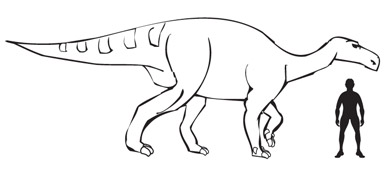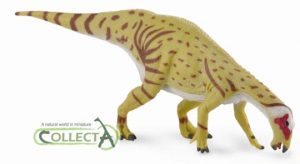Iguanodon or Iguanosaurus? That is a Great Question
The Problem with Iguanodon
Team members at Everything Dinosaur have been asked to explain to a local church group in Lewes, East Sussex about the difficulties regarding the taxonomic relationships of iguanodontids. Lewes, was the birth place and home of Dr Gideon Mantell, the scientist who was responsible for formerly naming and describing the dinosaur known as Iguanodon.
Iguanodon
Mantell figured and named Iguanodon based on the discovery of some fossilised teeth, he published his work in the journal the Philosophical Transactions of the Royal Society in 1825. Incidentally, he only gave a generic name for this material, opting not to refer to a specific or species name. These days such a generic name would be regarded as invalid, however, in the Georgian era, with the nascent study of fossils, this practice was permitted and Iguanodon gained acceptance. It was another scientist (Holl), who four years later ascribed a species name to the Mantell material.
The first species of Iguanodon was name I. anglicum (Holl, 1829), the specific name has been changed to I. anglicus to reflect the masculine Latinised version of the name, after all, the genus Iguanodon is in the masculine form of Latin. Mantell, had struggled to find a name for the animal whose teeth he had studied. By chance he had been shown a preserved specimen of a Caribbean iguana at the Museum of the Royal College of Surgeons and from the similarities in the teeth he came upon the idea of naming his new reptile after an iguana. He originally wanted to name his new genus Iguanosaurus (iguana lizard), but the name Iguanodon (iguana tooth) was chosen after it was suggested by another scientist (Conybeare).
All this took place many years before Sir Richard Owen coined the phrase Dinosauria to describe this group of strange “Saurian Reptiles”.
We now know that the iguanodontids were advanced ornithopods and they were a very successful group of dinosaurs, with a number of Early Cretaceous genera ascribed to this group. They were more heavily built than other ornithopods, with stout legs and deep, muscular tails that became slim and pointed at their distal end.
An Illustration of a Typical Iguanodontid
Picture credit: Everything Dinosaur
Although this most English of dinosaurs is still very much associated with the Wealden Formation and other UK locations such as the Isle of Wight, scientifically the term Iguanodon has become a “taxon waste basket” and much sorting out of individual genera has taken place, so much so that the International Commission on Zoological Nomenclature was petitioned to change the type genus from Mantell’s teeth to the more complete skeletons found in Belgium (Bernissart).
There may be several million years separating Mantell’s first iguanodontid I. anglicus and those Iguanodontidae described by Dollo after the discovery in 1878 of a number of near complete specimens – Iguanodon bernissartensis, but this and the revision of Iguanodon material into genera such as Dollodon and the American Dakotadon means that this once very “British” dinosaur is not that closely related to the United Kingdom anymore.
However, one light, gracile iguanodontid has been named Mantellisaurus to honour the doctor from Lewes who was responsible for naming and describing the Iguandontids in the first place.
A Model of Mantellisaurus
The image shows the CollectA Age of Dinosaurs Mantellisaurus drinking figure. To view this range of dinosaur and prehistoric animal models: CollectA Age of Dinosaurs Prehistoric Life Models.



